Will amaze you with its yield and taste - tomato "Bella f1" and the secrets of agricultural technology from experienced gardeners
Dutch tomatoes Belle f1 - one of the most unpretentious hybrids for cultivation in greenhouse conditions. The culture gives stable high yields even in an unfavorable environment. The plant is not afraid of cold, drought, lack of sunlight. In this article we will talk about the pros and cons of a hybrid, the features and rules of successful agricultural technology.
The content of the article
Description of the hybrid
Bella f1 from the Dutch company Enza Zaden bred specifically for growing in greenhouse and greenhouse conditions the third light zone of the country.
Bushes indeterminate, branched, with medium density foliage... The trunks are thick and knobby. The rhizome is well developed.
In the photo - tomatoes Bella f1.
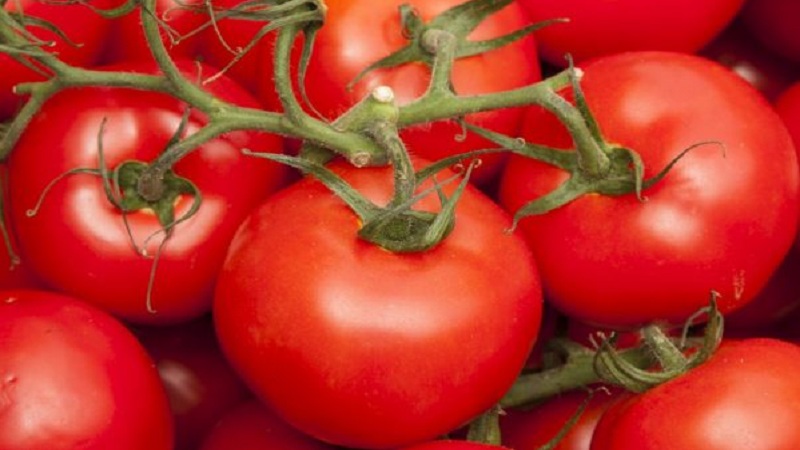
Reference. The third light zone of Russia includes: Belgorod, Bryansk, Vladimir, Voronezh, Kaliningrad, Kaluga, Kurgan, Kursk, Lipetsk, Moscow, Oryol, Ryazan, Sverdlovsk, Smolensk, Tambov, Tomsk, Tyumen regions, Krasnoyarsk Territory, Republic of Bashkortostan, Yakutia Republic of Tatarstan, Republic of Khakassia.
Distinctive features
The table shows the main characteristics of the hybrid.
| Indicators | Characteristic |
| Weight | 121-145 g (up to 180 g) |
| The form | Flat-round, slightly ribbed |
| Coloration | Red |
| Leaves | Medium green |
| Inflorescence type | Simple |
| Number of nests | Four and more |
| Pulp | Juicy but not watery |
| Taste | Sweet and sour, pleasant |
| Skin | Glossy, dense |
| Appointment | For salads, preserves, sauces and pasta |
| Bushes height | 1.5 m |
| Ripening period | 107-115 days after germination |
| Yield | 27-31 kg / m² |
| Sustainability | To tobacco mosaic virus, fusarium, verticilliosis |
| Transportability | High |
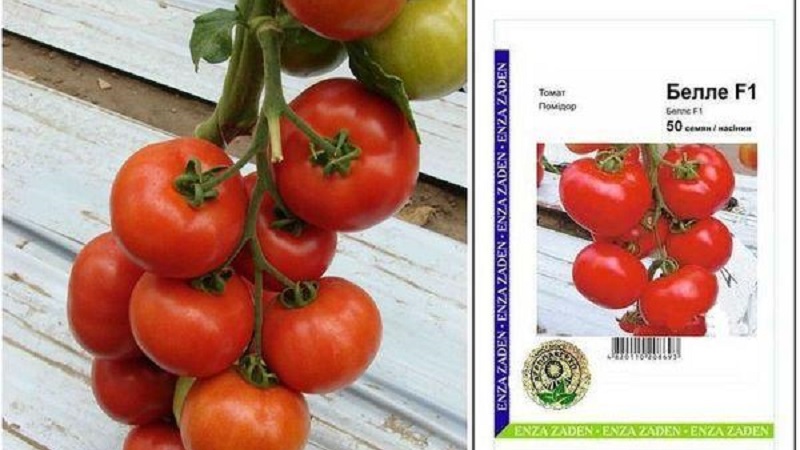
Growing seedlings
Seeds are sown 60-65 days before planting in the ground... Work begins in the second - third decade of March.
Soil preparation and sowing
Seed material does not require preliminary disinfection and steeping in growth promoters. The seeds have been processed in production.
For seedlings, take universal soil from a gardening store or prepare the soil mixture with your own hands. To do this, mix one part of peat, humus, turf, river sand, wood ash in a large container and add one tablespoon of superphosphate. The substrate is calcined in the oven or poured with potassium permanganate for disinfection.
Seedling containers (pots, plastic trays) are filled with moist soil, make a depression of 1.5–2 cm and spread the seeds at a distance of 2 cm. Then sprinkle with earth, cover with foil and leave the containers in a dark place.
After sprouting the film is removed, and the seedlings are taken out to a well-lit place.

Care
Seedlings are watered with warm, settled water, strictly under the root, with a pipette or syringe.
A pick is made after the appearance of 2-3 leaves in pots with a volume of 2 liters. For 60 days, the seedlings stretch quite strongly, therefore they need spacious containers to form a strong root system.
Before planting in the ground, seedlings are fertilized three times with minerals:
- For the first feeding after picking, use 2 tbsp. l. nitrogen per 10 liters of water or Agricola.
- The second top dressing is applied 12 days after the pick. Take 0.5 tbsp. l. nitroammophos for 5 liters of water. One seedling - 100 ml.
- A week before planting, fertilize with potassium and phosphorus: 1 tsp. superphosphate, 1 tbsp. l. ash per 5 liters of water. One seedling - 0.5 tbsp. solution.
Read also:
"Lily Marlene f1" - an early maturing hybrid with an exceptional taste
Lying variety for salads and preservation - hybrid "Malva f1"
Agrotechnics of tomatoes
The Dutch hybrid loves loose and nutritious soil.... The culture grows well in any climatic conditions, tolerates cold, heat and lack of sunlight. Even novice gardeners do not have special problems with caring for tomatoes.
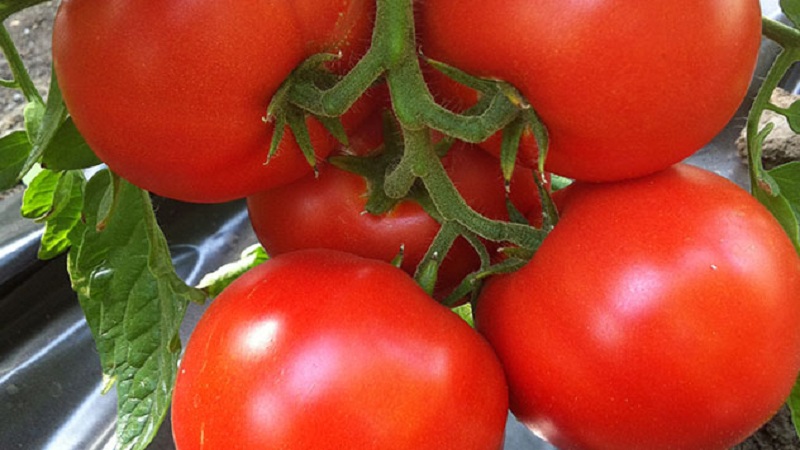
Landing
Before planting seedlings, the soil is fertilized compost, peat, sawdust and humus. The wells are dug up to a depth of 10 cm and filled with boiling water for disinfection.
Bushes slightly deepento allow the development of additional lateral roots. The soil is covered with mulch so as not to bother with constant loosening after each watering. For this, peat or sawdust is used. Mulch perfectly retains moisture in the soil, serves as additional protection against bacteria, and prevents the growth of weeds.
Care
An important condition for the successful cultivation of Bella tomatoes f1 - correct formation of bushes into one stem. Excess shoots are removed within 10-12 days after planting. The first inflorescence is formed above the ninth leaf, the subsequent ones - after three leaves.
Bushes are watered abundantly only the first week after transfer to the ground... Then the tomatoes are given moderate watering. The soil should dry out slightly before watering the plants again, and it is important to keep the leaves from wilting.
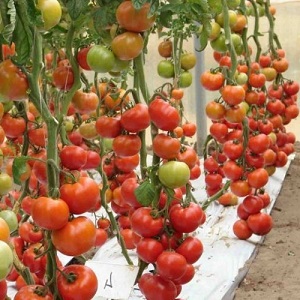 Tomatoes are fertilized every 14-21 days with complex mineral compounds:
Tomatoes are fertilized every 14-21 days with complex mineral compounds:
- The first top dressing is 14 days after planting. To do this, use a solution of one part mullein and five parts water.
- The second feeding - three weeks after the first (20 g of potassium salt, 20 g of superphosphate is diluted in 10 liters of water).
- During flowering, tomatoes are fed with boric acid at the rate of 2 g of substance per 2 liters of water.
- During the period of fruit emergence, potassium-phosphorus feeding is used (20 g of potassium salt, 20 g of superphosphate per 10 l of water).
Prevention of diseases and pests
Bellé f1 hybrid resistant to tobacco mosaic virus, fusarium, verticillosis, but has no immunity to late blight. When infected, brown spots appear on the leaves, stems, and soon on the fruits. If you do not take action on time, there is a risk of being left without a crop.
Folk remedies help fight late blight (calculated per 10 liters of water):
- 1 cup minced garlic and green shoots, 2 g potassium permanganate
- 1 glass of rock salt;
- 1 liter of kefir or milk whey;
- 1 liter of milk, 20 drops of iodine;
- a liter can of ash, 50 g of shavings of laundry soap.
The resulting solutions irrigate the bushes before the formation of ovaries, then every 14 days. The drugs "Quadris", "Quadro", "Consento" act quickly. Biological agents "Fitosporin", "Planriz", "Baktofit" are safer, but less effective.
Fight insects like whitefly, aphids, spider mites will help the means "Fitoverm", "Aktara", "Epin", "Zircon".
Harvesting and application of the crop
Harvest begin to be harvested 105-115 days after sprouting... Tomatoes tolerate long haul and are suitable for commercial cultivation.
The fruits have excellent taste and are suitable for fresh consumption, salting, pickling, making sauces and pasta.
More about tomatoes:
Advantages and disadvantages
 Hybrid has a number of undeniable advantages:
Hybrid has a number of undeniable advantages:
- suitability for low-volume growing technology;
- high productivity;
- excellent presentation;
- large fruits;
- resistance to adverse weather factors, including a lack of sunlight;
- early maturation;
- wonderful taste;
- excellent keeping quality;
- disease resistance of tomatoes.
Disadvantages of a hybrid are not significant:
- the seeds are not suitable for reuse in the next season, since they do not inherit the maternal genes;
- tall bushes need a garter and shaping.
Reference. Low-volume technology is a method of cultivating tomatoes without the use of soil on an industrial scale. The main advantages: there is no need to use agricultural technology for soil cultivation, the rejection of chemicals to protect against diseases and pests. Thus, the quality and environmental friendliness of vegetables is increased.
Farmers reviews
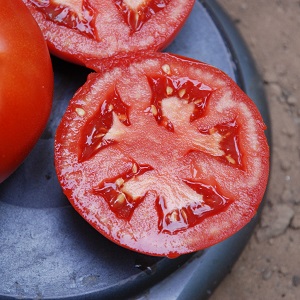 Bellé f1 hybrid won recognition and praise from farmers thanks to unpretentious care and wonderful taste.
Bellé f1 hybrid won recognition and praise from farmers thanks to unpretentious care and wonderful taste.
Leonid, Slavsk, Kaliningrad region: “I have been growing a hybrid since 2010. The harvest is always excellent, the quality of the fruit is at a high level. The bushes are tall, the brushes are powerful, every 3-4 leaves. Mineral dressing was often applied, watered moderately ".
Sofia, Livny, Oryol region: “I planted tomatoes for Bella last year. I was surprised by the abundant fruiting. Whole bunches of tomatoes have formed on each bush. There were no difficulties in leaving, the soil was fertilized with compost and peat. There was even no late blight. Tomatoes are very tasty, sweet and sour, juicy. "
Conclusion
The Dutch hybrid Belle F1 received recognition in Russia and feels great in the country's climatic conditions. The culture endures bad weather and lack of light. Farmers appreciate it for its unpretentiousness, high yield and excellent taste and marketability. Tomatoes are recommended for growing indoors under glass and film cover.